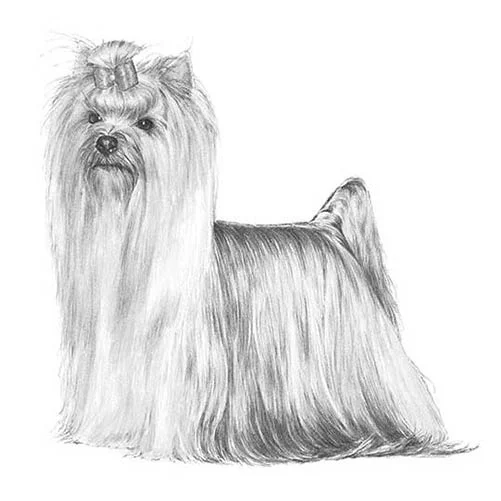|
AKC
Breed Standard

What is a Breed Standard? | | The easiest and clearest way to
define a breed standard is to read "A Breeder's Blueprint." The
foundation of any purebred dog's knowledge, be it a ring champion or a
companion, is its standard—a documented account of the ideal
representation of the breed. Perfect type, structure, gait, and
temperament are described by standards. Not every dog satisfies every
requirement of the breed standard. In actuality, the standard is a
conception that directs the creativity of individuals who take purebred
dog breeding, exhibition, and performance seriously. |
About the Breed:
Beneath
the dainty, glossy, floor-length coat of a Yorkshire Terrier beats the
heart of a feisty, old-time terrier. Yorkies earned their living as
ratters in mines and mills long before they became the beribboned
lapdogs of Victorian ladies. The Yorkshire Terrier is a compact,
toy-size terrier of no more than seven pounds whose crowning glory is a
floor-length, silky coat of steel blue and a rich golden tan. Don't let
the Yorkie's daintiness fool you. Tenacious, feisty, brave, and
sometimes bossy, the Yorkie exhibits all the traits of a true terrier.
Often named the most popular dog breed in various American cities,
Yorkies pack lots of big-town attitude into a small but self-important
package. They are favorites of urbanites the world over. Yorkies are
long-lived and hypoallergenic (the coat is more like human hair than
animal fur), and they make fine little watchdogs. This is a true
'personality breed,' providing years of laughs, love, and close
companionship. |
Official
Standard of the Yorkshire Terrier
General Appearance: That of a long-haired toy terrier whose blue and
tan coat is parted on the
face and from the base of the skull to the end of the tail and hangs
evenly and quite straight down
each side of body. The body is neat, compact and well proportioned. The
dog's high head
carriage and confident manner should give the appearance of vigor and
self-importance.
Head: Small and rather flat on top, the skull not too prominent or
round, the muzzle not too long,
with the bite neither undershot nor overshot and teeth sound. Either
scissors bite or level bite is
acceptable. The nose is black. Eyes are medium in size and not too
prominent; dark in color and
sparkling with a sharp, intelligent expression. Eye rims are dark. Ears
are small, V-shaped,
carried erect and set not too far apart.
Body: Well proportioned and very compact. The back is rather short, the
backline level, with
height at shoulder the same as at the rump.
Legs and Feet: Forelegs should be straight, elbows neither in nor out.
Hind legs straight when
viewed from behind, but stifles are moderately bent when viewed from
the sides. Feet are round
with black toenails. Dewclaws, if any, are generally removed from the
hind legs. Dewclaws on
the forelegs may be removed.
Tail: Docked to a medium length and carried slightly higher than the
level of the back.
Coat: Quality, texture and quantity of coat are of prime importance.
Hair is glossy, fine and silky
in texture. Coat on the body is moderately long and perfectly straight
(not wavy). It may be
trimmed to floor length to give ease of movement and a neater
appearance, if desired. The fall on
the head is long, tied with one bow in center of head or parted in the
middle and tied with two
bows. Hair on muzzle is very long. Hair should be trimmed short on tips
of ears and may be
trimmed on feet to give them a neat appearance.
Colors: Puppies are born black and tan and are normally darker in body
color, showing an
intermingling of black hair in the tan until they are matured. Color of
hair on body and richness
of tan on head and legs are of prime importance in adult dogs, to which
the following color
requirements apply: Blue - Is a dark steel-blue, not a silver-blue and
not mingled with fawn,
bronzy or black hairs. Tan - All tan hair is darker at the roots than
in the middle, shading to still
lighter tan at the tips. There should be no sooty or black hair
intermingled with any of the tan.
Color on Body: The blue extends over the body from back of neck to root
of tail. Hair on tail is
a darker blue, especially at end of tail.
Headfall: A rich golden tan, deeper in color at sides of head, at ear
roots and on the muzzle, with
ears a deep rich tan. Tan color should not extend down on back of neck.
Chest and Legs: A bright, rich tan, not extending above the elbow on
the forelegs nor above the
stifle on the hind legs.
Weight: Must not exceed seven pounds.
Disqualifications: Any solid color or combination of colors other than
blue and tan as described
above. Any white markings other than a small white spot on the
forechest that does not exceed 1
inch at its longest dimension. | | |
|





